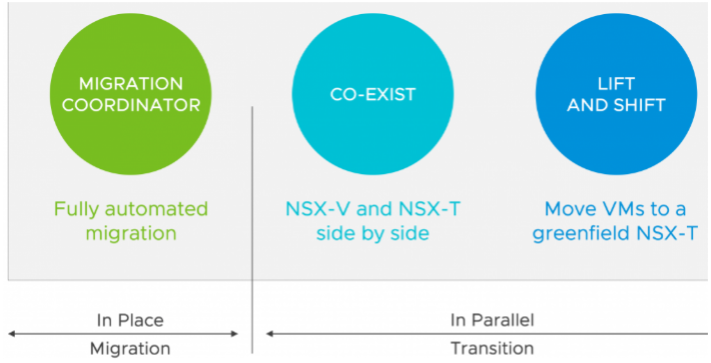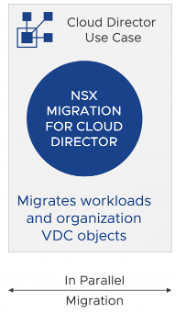NSX for vSphere is scheduled for end of general support (EOGS) in January 2022. VMware Cloud Providers should already be migrating or have migrations plans in place for their tenants to deploy NSX-T environments. This blog describes the details and tools for cloud providers to consider when migrating to NSX-T to ensure a smooth transition.
Your path to migration depends on a couple of factors: 1) whether you are using the VMware Cloud Director (VCD for multi-tenant environments) or not; 2) an assessment to determine pre-requisites based on the network topology, minimizing migration downtime while managing workload domains, and post-migration cleanup and verification. Based on the factors above, you have a choice of methods outlined below, whichever is appropriate for your situation:
- NSX for vSphere (NSX-V) not using VCD: If you have deployed an NSX-V environment that doesn’t use VCD, you can start migration right away using either of the following methods:
- “In-Place” method: This is a simpler method that doesn’t require dedicated hardware and uses NSX-T’s built-in Migration Coordinator, if it can be used with your topology.
- “In-Parallel” method: This deploys NSX-T along with the existing NSX-V based infrastructure and migrates workloads in two ways: 1) New workloads are deployed on NSX-T, and older ones are allowed to be decommissioned over time. 2) workloads are lifted and shifted to the NSX-T infrastructure.
To help you get started on the methods outlined above, here are the following resources to successfully plan and migrate to NSX-T:
- Overview blog post on the various approaches to migration, the steps and processes.
- Comprehensive website for partners that includes information to Get Started, FAQs and other resources.
- How to Migrate from VMware NSX for vSphere to NSX-T Guide a detailed. Technical guide.
- Step by step instructional video: Using the NSX-T Migration Coordinator
- Educational: V2T Migration Course for a 3-day hands on training.
- Also check out the NSX V2T Migration Resources on Partner Connect Portal (login required) for more information.
If you use VCD to manage your multi-tenant deployments, please use the method outlined for VCD environments below.
- NSX for vSphere using VCD: For NSX-V environments that use VCD, VMware has developed an automated capability on VCD called VMware NSX Migration for VMware Cloud Director to ease migration to NSX-T. Please review the list of features supported in the VCD 10.2 user guide carefully. If you have deployed an environment with supported NSX-T features in VCD 10.2, you can start planning for migration right away by downloading VMware NSX Migration for VMware Cloud Director 1.2. This was released in February 2021 to facilitate migration for VCD environments only. The latest release of VMware NSX Migration for VMware Cloud Director 1.2.1 that adds assessment mode capability.
The following resources are available to guide you through the steps involved:
-
- Comprehensive blog about the release is a great way to get started, also explains how it works, technical overview and links to videos and resources needed for migration.
- Latest blog on VMware NSX Migration for VMware Cloud Director 1.2.1.
- Short demo on YouTube (focusing on DFW and LB migration)
- Video: Feature Friday Episode 18 – VMware NSX Migration for VMware Cloud Director 1.2
- Download Release binaries and User Guide for 1.2 NSX Migration for VMware Cloud Director
In the event your environment has dependencies on NSX-T features not yet supported by VCD, please be assured we are working on plans to address the timelines for those VMware Cloud Providers who are waiting for later VCD releases to migrate. We ask for your patience as we finalize the plans.
As a valued VMware Cloud Provider partner, we would like you to plan the migrations while coordinating with your tenants and feel assured that VMware is ready to support and help with the transition. Please do not hesitate to reach out to your VMware contacts with any questions.
We are excited about moving forward with VMware NSX-T and as always are focused on innovating and improving to help serve our VMware Cloud Provider partners by adding new managed service offerings to their portfolios. We will continue posting new technical and product information on our VMware Cloud Provider blogs. Join us by following the blog directly using the RSS feed, on Facebook, LinkedIn and on Twitter, and by visiting our YouTube channel too.
As always, thank you, and please stay safe.





